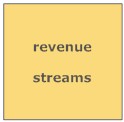 Section
Navigation
Section
Navigation
8. Models and Strategy
8.1 eBusiness in Context: US Scene
8.2 Strategic Management
8.3 Grouping by Strategy
8.4 Business Models
8.5 Customer Segments
8.6 Customer Channels
8.7 Customer Relationships
8.8 Key Resources
8.9 Key Partnerships
8.10 Key Activities
8.11 Value Propositions
8.12 Cost Structure
8.13 Revenue Streams
8.14 Internet Revenue Models
8.15 Strategy
8.16 Company Valuation
8.17 Measures & Ratios
8.18 Fundamental Analysis
8.19 Efficient Markets
8.20 Neoclassical Economics
 8.13
Revenue Streams
8.13
Revenue Streams
Revenue Streams is the building block representing the cash (not profit,
which is revenue minus costs) a company generates from each Customer Segment.
 |
Such Revenues are the lifeblood of a company. Revenue Stream may have different pricing mechanisms, such as fixed list prices, bargaining, auctioning, market dependent, volume dependent, or yield management. |
Revenue Streams can be generated in many ways:
Asset sale
Ownership rights are sold of a physical product. Amazon.com sells books, music, consumer electronics, etc. online. Ford sells automobiles, which buyers are free to drive, resell, or dispose of.
Usage fee
Use of a particular service is sold, the amount paid depending on the usage. A telecom company may charge on the type of call and minutes spent on the phone. A hotel charges customers by the type of room and nights occupied. A delivery service charges customers for the delivery of a parcel from one location to another.
Subscription fees
Here a continuous or repeated access to a service is sold. A gym sells its members a monthly or yearly subscription for access to its exercise facilities. World of Warcraft Online, a Web-based computer game, allows users to play an online game in exchange for a monthly subscription. Nokia's music service gives users access to a music library for a subscription fee.
Lending/Renting/Leasing
The Revenue Stream is created by granting someone the exclusive right to a particular asset for a fixed period in return for a fee. Lenders receive recurring revenues, and lessees pay a fraction of the full cost of ownership. Rentals (cars, cottages, farm machinery, etc.) are familiar examples.
Licensing
Here the content owners retain copyright while selling licenses to third parties. Media companies obtain their revenues in this manner, as do patent holders of particular technologies.
Brokerage fees
Revenue here derives from an intermediation services performed on behalf of two or more parties. Brokers and real estate agents earn a commission each time they successfully match a buyer with seller. Credit card providers earn revenues by taking a percentage of the value of each sales transaction executed between credit card merchants and customers.
Advertising
Fees for advertising a particular product, service or brand form the basis of this Revenue Stream. Newspapers, and the media industry generally, rely on this approach, which has spread to website advertising and to software sales.
Pricing Mechanisms
Pricing may be Fixed or Dynamic. The first is based on static variables. A List Price is as stated in the brochure etc., but may be subject to discounts depending on the number of items purchased or service required. Price may also be tailored to characteristics of the particular Customer Segment. Dynamic Pricing, by contrast, depends on market conditions, and is subject to the power and negotiating skill of the purchaser. In Yield Management the price depends on the inventory and time of purchase (as in airline seats or hotel rooms). Price in real-time markets is dynamically established by supply and demands conditions. Prices at auction result from competitive bidding.
Relevant Case Studies
Nitendo reinvested its revenue streams in low-tech games.
Amazon reinvested book sale revenues into general retail and then computing services.
Dale Abrahams had no significant advantages in any business element, and so lost money.
Intel spent billions of its revenues on marketing its logo to PC purchasers, but got the money back through premium-priced chips.
PayPal had to spend lavishly on marketing a 'sure fire thing'.
 Questions
Questions
1. What are revenue streams exactly? Why are they important?
2. What are the seven types of revenue streams?
3. Describe the different pricing mechanisms.
4. What ebusiness approaches and technology bear on revenue streams?
 Sources
and Further Reading
Sources
and Further Reading
1. Business Model Generation: A Handbook for Visionaries,
Game Changers, and Challengers by Alexander Osterwalder and Yves
Pigneur. Wiley 2010.